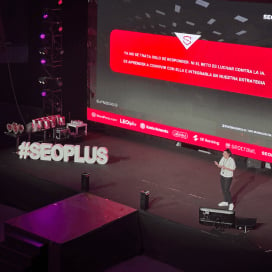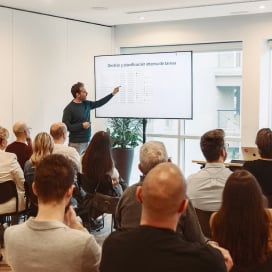Written by Fernando Maciá
Index
- Demand stays the same but how we search is changing
- From links to answers: the era of generative results
- Is AI really gaining traction as a search engine?
- How to optimize for AI-powered search: practical strategies
- Measurement and monitoring in the new paradigm
- Agentic search: the next step in evolution
- The future is now: keys to adaptation
No day goes by without a new headline declaring the death of Google, the obsolescence of traditional SEO, or the ultimate revolution AI will bring to online search. However, the data tells a very different story: while we all debate the future of search, users continue to turn to the internet to meet the same needs as before. What has changed is that they now have more options for where and how to search. Let’s take a look at what remains and what’s changing in search in 2025.
Demand stays the same but how we search is changing
Google Trends data shows that popular searches like “New York flight”, “LED bulbs”, “omelette recipe”, or “all-inclusive hotel” have remained stable over the past twelve months. People still need information, products, services, and apps… What has radically changed is the landscape of options for finding them in the vast universe of the web.
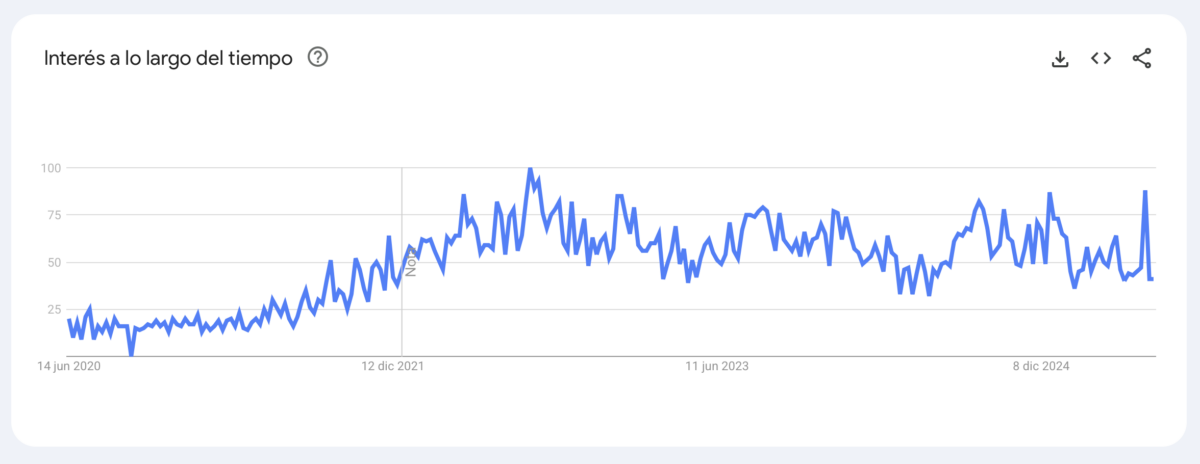
Search has fragmented into multiple scenarios depending on factors like the user’s age, how much they know about how to solve their need, the type of product or service, the level of decision risk, or whether it’s a personal or professional context. This fragmentation has ended Google’s monopoly as the dominant search engine and ushered in a diverse ecosystem where traditional search engines like Google coexist with vertical search platforms like Booking, Amazon or Skyscanner, AI chatbots like ChatGPT or Claude, and social media platforms like Instagram, Pinterest or TikTok. All of them now play a role as potential discovery and research touchpoints throughout the purchase decision journey.
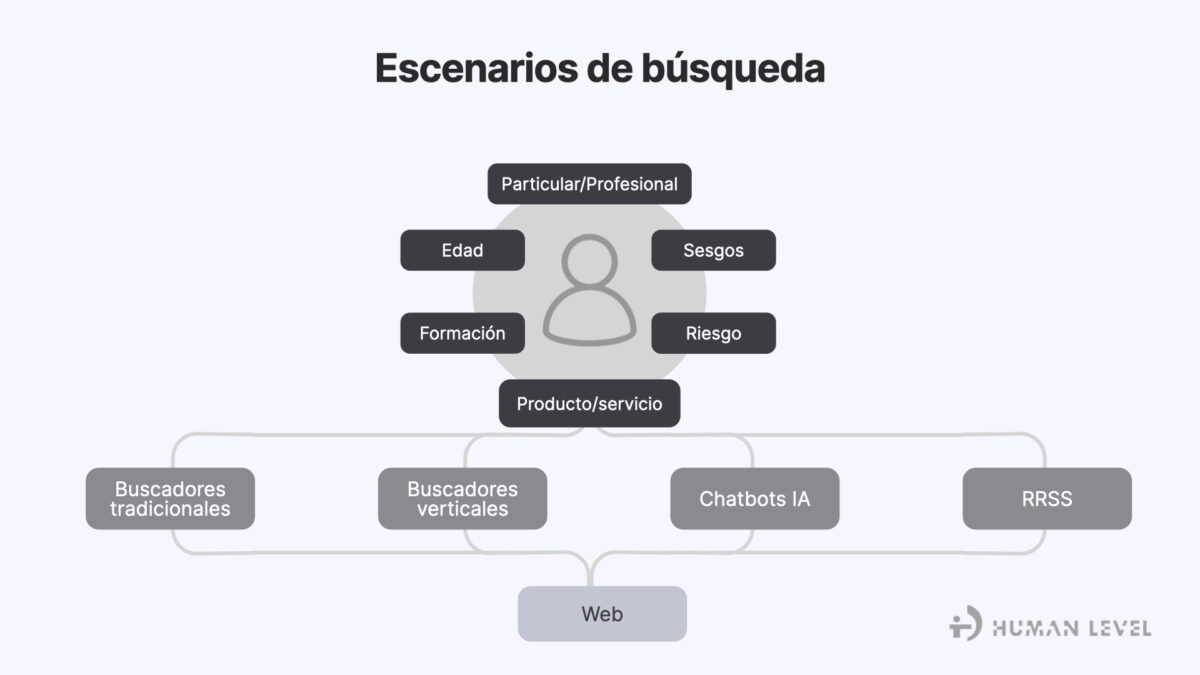
This diversification is no accident. Over the history of the internet, we’ve seen how each generation adopts different search patterns: while seasoned professionals may still turn to Google for complex queries, younger generations naturally turn to TikTok, Instagram, or ChatGPT for discovery and decision-making (though recent research by Morgan Stanley indicates that Gen Z may be abandoning Amazon in favor of Google and social media influencers).
From links to answers: the era of generative results
Google AI Overviews, or AI-generated summaries, represent perhaps the most visible shift in traditional search results. These blocks of AI-generated content appear before classic organic results—and sometimes even above paid ads—dramatically altering the click distribution on SERPs and causing the well-known “crocodile effect” on impressions and click tracking in Google Search Console.
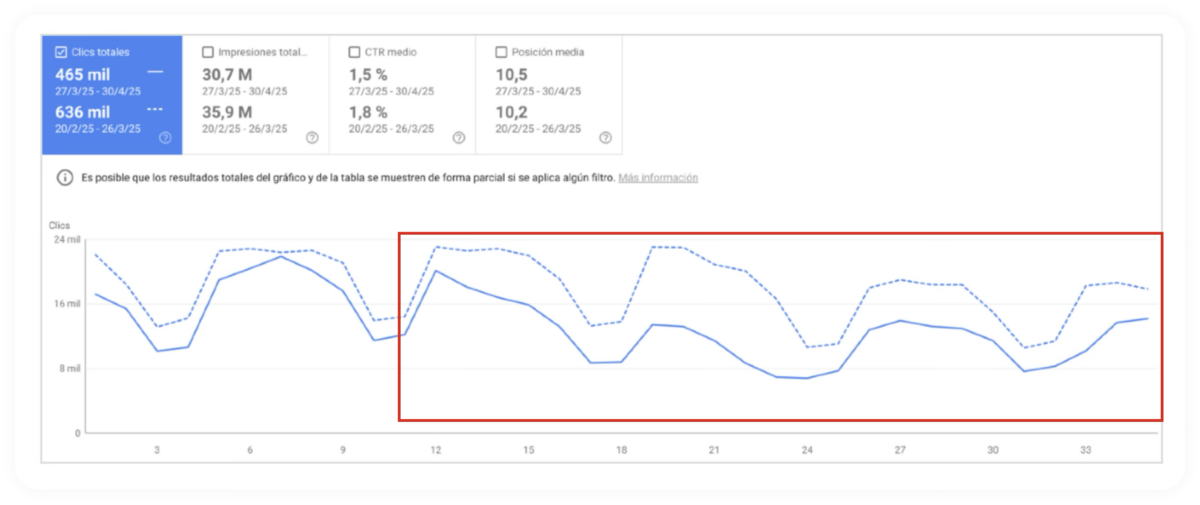
In analyses carried out by the Human Level team, we observed some overlap between traditionally top-ranking links and those cited or linked in AI Overviews, though this correlation is far from consistent across all content.
While click losses reach 35–40% for informational queries when generative results are shown, the impact on transactional searches is minimal, with AI Overviews appearing in just over 4% of these cases.
With the rollout of Google AI Mode (now publicly available in the U.S.), CTR impact may increase even further, something we’ll need to track through Google Search Console now that Google has confirmed it will start displaying this information.

But Google is not the only player in this space. SearchGPT combines OpenAI’s LLMs with Bing’s index, offering both generative answers and traditional links. Perplexity positions itself as a conversational engine that cites web sources. Gemini leverages Google’s index to enrich its responses. Claude has started showing links in some markets.
All these models converge on one key point: pure LLMs like ChatGPT are not that useful without access to up-to-date information (RAG – Retrieval Augmented Generation), and traditional search engines become more useful when they integrate AI capabilities to interpret complex queries and generate contextual answers.
Is AI really gaining traction as a search engine?
Numbers are the best way to cut through the noise of (especially self-interested) opinions, so let’s look at a few figures to better gauge ChatGPT’s impact and potential evolution.
OpenAI receives approximately 5 billion monthly visits—an impressive number that pales in comparison to Google’s 90 billion monthly visits. Besides, people use ChatGPT for much more than search. If we discount use cases that Google could also resolve, ChatGPT processes around 37.5 million search-like queries daily—a far cry from Google’s 14 billion daily searches (according to this Sparktoro study).
Meanwhile, the market share of traditional search engines remains practically unchanged despite AI’s rise and Microsoft’s (Bing) alliance with OpenAI (ChatGPT). Google retains its absolute dominance, Bing has seen little change, and new players like Perplexity or SearchGPT are still confined to niche segments.
This doesn’t mean we should ignore these platforms. On the contrary, they offer additional visibility opportunities for brands that adapt to their dynamics. But it also confirms that traditional SEO remains the foundational pillar of any online visibility strategy—even after the rise of AI.
How to optimize for AI-powered search: practical strategies
Traditional SEO and AI SEO aren’t opposing approaches, but complementary ones. In fact, we might consider AI optimization as an “additional layer” of SEO. Solid technical SEO provides the foundation that also helps AI platforms understand and classify content—though there are specific aspects to keep in mind. While traditional SEO aims to rank high in results, AI SEO focuses on maximizing the chance of being cited or linked to as a trusted source—either directly or via mentions in third-party content (such as roundup articles, comparison guides, industry reports, studies, etc.).
From keywords to prompts: how users express search intent
Users interact very differently with traditional search engines compared to AI platforms. Traditional keywords are short (2–3 words), while prompts tend to be longer, more specific, and conversational in tone. However, only 30% of prompts directed at AI platforms would qualify as queries Google could also answer effectively, according to this Sparktoro study.
This behavior difference should inform our content strategy. We need to respond to search intent expressed naturally and conversationally—as if the user were asking a store clerk or a human expert.
Anticipating search intent
Generative results rely on a technique that relates the user’s original query to additional synthetically generated ones, known as “query fanout.” It works as shown in the graphic below.
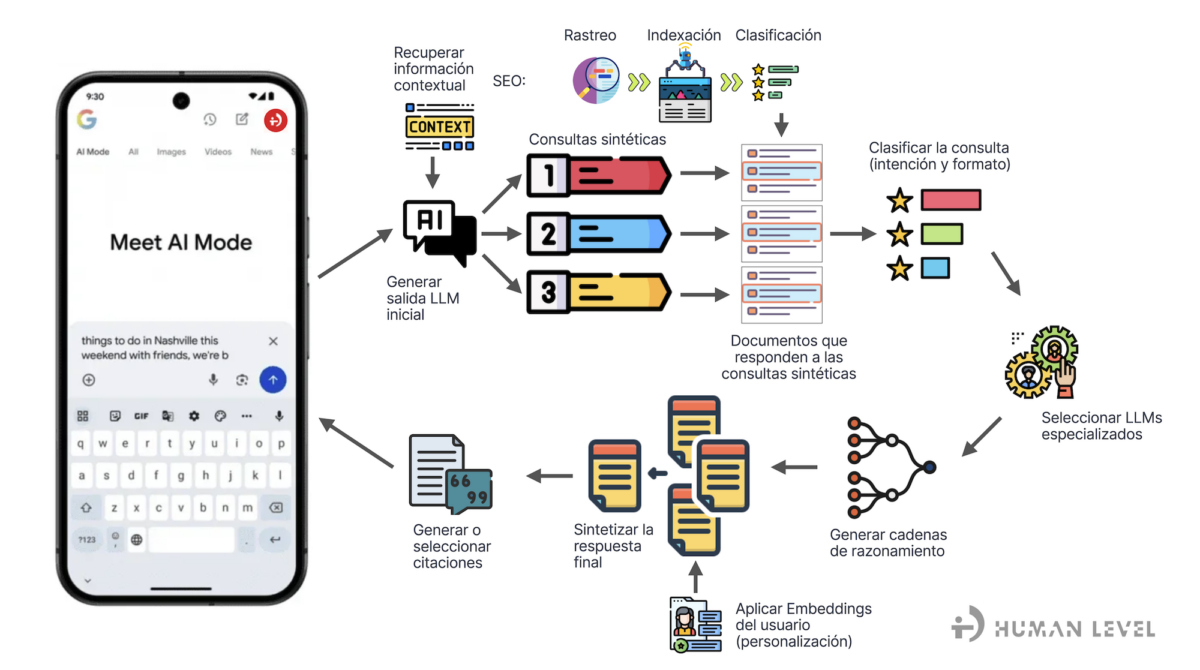
Features like Google’s “People Also Ask”, or platforms like AlsoAsked.com and AnswerThePublic.com, help identify related questions users ask throughout the purchase decision process (customer journey). Creating high-quality content that addresses those questions and motivations improves our chances of showing up in both traditional results and AI Overviews or AI platforms.
This strategy can be systematically applied to each product or service line and target segment—covering every phase of the customer journey. The key is delivering complete, authoritative, well-structured answers that AI systems can easily extract and cite.
The EEAT criteria—Experience, Expertise, Authority, and Trust (EEAT)—become even more important in the context of AI. Automated systems need clear signals to identify trustworthy, expert sources.
This means:
- Demonstrating first-hand experience in your field or subject matter.
- Building and maintaining a healthy ecosystem of links and mentions from other authoritative sources to help AI systems associate your brand with the most relevant sector entities.
- Developing a credible presence in media, forums, comparison platforms, rankings, etc.
- Investing in brand recognition and public relations (PR).
Structured data—more important than ever
Structured data provides the semantic context that AI algorithms need to understand not just keywords, but also meaning and entity relationships. It enables efficient information extraction and increases the likelihood of citation in AI-generated summaries.
Multichannel strategy: boosting discoverability beyond your website
Visibility on AI-powered search engines isn’t just about optimizing your site. You need a multichannel content strategy that includes:
- Publishing in multiple formats: text, video, infographics.
- Presence in industry-specific online media and publications.
- Active participation in relevant forums and communities.
- Contributing data, analysis, and testimonials to reinforce your authority—publishing studies, comparisons, insights, or proprietary data.
Mentions and references on third-party sites—even without links—can generate indirect traffic via navigational queries (such as brand name searches in Google), which may appear as “direct” in analytics, complicating attribution but confirming the effectiveness of a distributed strategy.
Measurement and monitoring in the new paradigm
Measuring AI’s impact on our visibility strategies requires new tools and methodologies. At Human Level, we’ve developed proprietary tools to monitor several critical aspects:
Monitoring AI Overviews
The system developed by Human Level tracks which queries trigger AI Overviews, how many sources are cited, whether our client’s domain appears, and which competitors are mentioned. Currently, AI Overviews appear in 56% of the queries we monitor, especially in informational searches linked to blog posts, FAQs, glossaries, and educational resources.
Visibility in AI search engines
We’ve also developed tools to analyze results in ChatGPT. Based on a selection of likely prompts users might use to find a website, we collect data on mentions, citations, and links.
However, with generative results, it’s important to understand that specific rankings can’t be guaranteed—we can only measure the comparative likelihood of appearing. By nature, LLM-generated results aren’t usually reproducible and have limited stability.
Key performance indicators
Traditional KPIs evolve in this new context:
- Business impact: how your discoverability strategy drives actual sales.
- CTR vs. position: discrepancies between these two in Google Search Console (e.g. high position, low CTR) may indicate the presence of a featured result or AI Overview block.
- Direct traffic: increases in direct traffic may stem from AI-generated citations or mentions.
- Mentions and references: in AI, these are as important as links are in traditional SEO.
- Likelihood of citation: this is a new, essential success metric.
Agentic search: the next step in evolution
As we adapt to today’s changes, the next evolution is already taking shape: agentic search and intelligent agents. This new paradigm goes beyond getting answers—it’s about AI taking concrete actions on our behalf.
In this scenario, websites will be able to offer tools and resources directly to LLMs, enabling users to complete tasks from within the AI chat interface: place orders, access subscription info, receive stock alerts, or generate customized presentations with discounted products.
These capabilities are built on existing web standards, easing adoption. Anthropic’s Model Context Protocol (MCP) uses HTTP, SSE, and JSON-RPC, while Google’s A2A protocol is being developed for agent communication. If the LLM is running on a mobile app, it may even be able to generate files or access local device storage.
For companies, this is an opportunity to create new direct touchpoints with potential customers—where visibility and technical integration will determine your ability to benefit from these automated interactions.
The future is now: keys to adaptation
AI-powered search is still an emerging phenomenon, but it’s also a present reality that requires attention, tracking, and strategic foresight. AI search engines may not steal significant traffic from Google, but they are creating new search opportunities users hadn’t considered before.
However, perspective is critical. We can’t talk about “ranking” in AI search engines the same way we do with Google. What we can do is take action to increase our chances of being cited or linked to. The variability and personalization of these systems mean that traditional ranking metrics lose relevance.
The companies that adapt best will be those that:
- Maintain a solid technical SEO foundation.
- Implement conversational, educational content strategies.
- Build a cohesive multichannel presence (connecting the brand to key entities referenced in related queries—whether keywords or prompts).
- Invest in brand authority and media relations.
- Adopt measurement systems tailored to the new paradigm.
Artificial intelligence is transforming search, but it’s not replacing it. It’s expanding the opportunities for brands that know how to navigate this new complexity—with strategy, insight, and the right tools.
At Human Level, we’ve been anticipating shifts in the search landscape for over two decades. More than a year ago, we launched our AI Lab to explore and capitalize on the opportunities AI brings to online search. If your company wants to develop a visibility strategy that leverages both traditional search engines and new AI platforms, we’d love to explore with you how our methodologies can boost your digital discoverability in this new paradigm.
